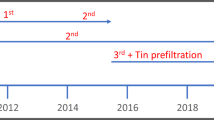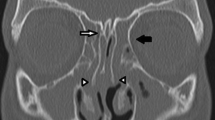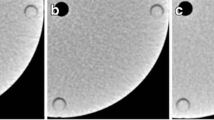Abstract
Objective
Computed tomography (CT) of the paranasal sinus is the standard diagnostic tool for a wide range of indications in mostly younger patients. This study aims to assess the image quality of CT of the sinus by using a high-pitch dual-source technique with special regard to the radiation dose.
Methods
Examinations were performed on a second-generation dual-source CT with a pitch factor of 3.0 (dual-source mode). Images were compared with those with a pitch factor of 0.9 on the same system (single-source mode) and with those of 16-slice CT. Image quality was evaluated by four blinded readers using a 5-point scale (1 = poor, 5 = excellent). Comparison of the dose length product (DLP) was used to estimate radiation exposure.
Results
Seventy-three consecutive patients underwent imaging with the proposed CT protocols. The viewers rated the image quality of the dual-source image sets as nearly as good (3.62) as the single-source images on the same device (4.18) and those on 16-slice CT (3.7). DLP was cut to half of the dose [51 mGycm vs. 97.8 mGycm vs. 116.9 mGycm (p < 0.01)].
Conclusions
Using the proposed dual-source mode when examining the paranasal sinus, diagnostic image quality can be achieved while drastically lowering the patient's radiation exposure.



Similar content being viewed by others
References
Vogl TJ, Mack MG, Balzer J (2000) Chronic infections of the paranasal sinuses. Radiologe 40:500–506
Dammann F (2007) Imaging of paranasal sinuses today. Radiologe 47(576):578–583
Hart D, Wall BF (2004) UK population dose from medical X-ray examinations. Eur J Radiol 50:285–291
Brenner DJ, Hall EJ (2007) Computed tomography-an increasing source of radiation exposure. N Engl J Med 357:2277–2284
Abul-Kasim K, Strombeck A, Sahlstrand-Johnson P (2009) Low-dose computed tomography of the paranasal sinuses: radiation doses and reliability analysis. Am J Otolaryngol. doi:10.1016/j.amjoto.2009.08.004
Petersilka M, Bruder H, Krauss B, Stierstorfer K, Flohr TG (2008) Technical principles of dual source CT. Eur J Radiol 68:362–368
Leschka S, Stolzmann P, Desbiolles L, Baumueller S, Goetti R, Schertler T, Scheffel H, Plass A, Falk V, Feuchtner G, Marincek B, Alkadhi H (2009) Diagnostic accuracy of high-pitch dual-source CT for the assessment of coronary stenoses: first experience. Eur Radiol 19:2896–2903
Sommer WH, Schenzle JC, Becker CR, Nikolaou K, Graser A, Michalski G, Neumaier K, Reiser MF, Johnson TR (2009) Saving dose in triple-rule-out computed tomography examination using a high-pitch dual spiral technique. Invest Radiol 45:64–71
Achenbach S, Marwan M, Schepis T, Pflederer T, Bruder H, Allmendinger T, Petersilka M, Anders K, Lell M, Kuettner A, Ropers D, Daniel WG, Flohr T (2009) High-pitch spiral acquisition: a new scan mode for coronary CT angiography. J Cardiovasc Comput Tomogr 3:117–121
Simmen D, Schuknecht B (1997) Computerized tomography of paranasal sinuses–a preoperative check list. Laryngorhinootologie 76:8–13
Bongartz G, Golding SJ, Jurik AG, Leonardi M, Van Persijn van Meerten E, Geleijns J, Jessen KA, Panzer W, Shrimpton PC, Tosi G (1999) European Guidelines on Quality Criteria for Computed Tomography. Report EUR 16262
Dammann F, Momino-Traserra E, Remy C, Pereira PL, Baumann I, Koitschev A, Claussen CD (2000) Radiation exposure during spiral-CT of the paranasal sinuses. Rofo 172:232–237
Little MP, Wakeford R, Tawn EJ, Bouffler SD, Berrington de Gonzalez A (2009) Risks associated with low doses and low dose rates of ionizing radiation: why linearity may be (almost) the best we can do. Radiology 251:6–12
Tubiana M, Feinendegen LE, Yang C, Kaminski JM (2009) The linear no-threshold relationship is inconsistent with radiation biologic and experimental data. Radiology 251:13–22
Cohen MD (2009) Pediatric CT radiation dose: how low can you go? AJR Am J Roentgenol 192:1292–1303
Smith-Bindman R, Lipson J, Marcus R, Kim KP, Mahesh M, Gould R, Berrington de Gonzalez A, Miglioretti DL (2009) Radiation dose associated with common computed tomography examinations and the associated lifetime attributable risk of cancer. Arch Intern Med 169:2078–2086
Martin CJ, Sutton DG, Sharp PF (1999) Balancing patient dose and image quality. Appl Radiat Isot 50:1–19
Wall BF, Hart D (1997) Revised radiation doses for typical X-ray examinations. Report on a recent review of doses to patients from medical X-ray examinations in the UK by NRPB. National Radiological Protection Board. Br J Radiol 70:437–439
Aalokken TM, Hagtvedt T, Dalen I, Kolbenstvedt A (2003) Conventional sinus radiography compared with CT in the diagnosis of acute sinusitis. Dentomaxillofac Radiol 32:60–62
Klose KC, Elies W, Sondermann U (1991) The accuracy of plain-film radiology in demonstrating the shadows of the pneumatic spaces of the skull–a comparison with computed tomography. Rofo 155:199–206
Batra PS, Kanowitz SJ, Citardi MJ (2008) Clinical utility of intraoperative volume computed tomography scanner for endoscopic sinonasal and skull base procedures. Am J Rhinol 22:511–515
Yu L, Vrieze TJ, Bruesewitz MR, Kofler JM, DeLone DR, Pallanch JF, Lindell EP, McCollough CH (2010) Dose and image quality evaluation of a dedicated cone-beam CT system for high-contrast neurologic applications. AJR Am J Roentgenol 194:193–201
Fahrig R, Dixon R, Payne T, Morin RL, Ganguly A, Strobel N (2006) Dose and image quality for a cone-beam C-arm CT system. Med Phys 33:4541–4550
Acknowledgements
Ralf Werner Bauer and Matthias Josef Kerl are Research Consultants for Siemens AG.
Author information
Authors and Affiliations
Corresponding author
Rights and permissions
About this article
Cite this article
Schell, B., Bauer, R.W., Lehnert, T. et al. Low-dose computed tomography of the paranasal sinus and facial skull using a high-pitch dual-source system—First clinical results. Eur Radiol 21, 107–112 (2011). https://doi.org/10.1007/s00330-010-1892-6
Received:
Revised:
Accepted:
Published:
Issue Date:
DOI: https://doi.org/10.1007/s00330-010-1892-6




